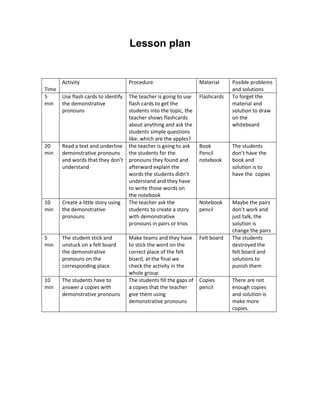
Lesson plan teaches demonstrative pronouns
- 1. Lesson plan Activity Procedure Material Posible problems Time and solutions 5 Use flash cards to identify The teacher is going to use Flashcards To forget the min the demonstrative flash cards to get the material and pronouns students into the topic, the solution to draw teacher shows flashcards on the about anything and ask the whiteboard students simple questions like: which are the apples? 20 Read a text and underline the teacher is going to ask Book The students min demonstrative pronouns the students for the Pencil don’t have the and words that they don’t pronouns they found and notebook book and understand afterward explain the solution is to words the students didn’t have the copies understand and they have to write those words on the notebook 10 Create a little story using The teacher ask the Notebook Maybe the pairs min the demonstrative students to create a story pencil don’t work and pronouns with demonstrative just talk, the pronouns in pairs or trios solution is change the pairs 5 The student stick and Make teams and they have Felt board The students min unstuck on a felt board to stick the word on the destroyed the the demonstrative correct place of the felt felt board and pronouns on the board, at the final we solutions to corresponding place check the activity in the punish them whole group 10 The students have to The students fill the gaps of Copies There are not min answer a copies with a copies that the teacher pencil enough copies demonstrative pronouns give them using and solution is demonstrative pronouns make more copies.
- 2. Justification The lesson plan is based on the theories and concepts about the second language acquisition and the adolescent development. The first activity is to use flash cards to teach demonstrative pronouns, we consider the critical period hypothesis wish says that once a child has reach the puberty its brain's natural ability to acquire language significantly diminishes, we have to find other effective ways to they learn, we can’t rely on any mental mechanisms used to acquire the first language, this is why we decided to use flashcards because nobody learn the first language through flashcards, this is other mechanism and according to the behaviorist theory the correct language production by repetition and memorization creates the best habits to learn a new language. The second activity is to read a text and underline demonstrative pronouns and words they don’t understand, and at the final of the activity the teacher explain them what they didn’t understand, the information-processing perspective includes perception and the input of new information; the formation and organization of information and output strategies, with this activity the students can store, form and organize the terms we explain them, they will have input of new information and output strategies with the terms and rules of the text that we explain them, it also works to avoid fossilization. This activity is for 20 minutes because the concrete operations stage of the egocentrism is from 7 to 15 years old and at that age they have logical and multidirectional deductions, it means that this activity takes time to them, they think more and harder, also other important factor is that the students are completely beginners in the English. The third activity is to create a story using demonstrative pronouns, this is because in the class we observe that the students showed diffusion, this is low level of search and identity and with this story they’re going to use their own ideas, this works to they know themselves better and to motivate them using their creativity at the same time they learn the topic. The fourth activity is to make teams to stick and unstuck demonstrative pronounces on a felt board, the ability to memorize and language learning strategies are factors that affect the second language learning, this facilitate them how to memorize and learn because they’re playing and repainting. The final activity is to answer copies with demonstrative pronouns, this is to evaluate the students learning, solve doubts and avoid fossilization.